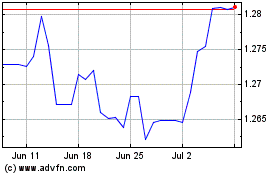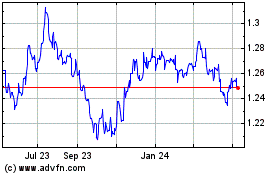U.S. Dollar Mixed After ADP Data
April 03 2019 - 5:39AM
RTTF2
The U.S. dollar came in mixed against its major counterparts in
the European session on Wednesday, after a data showed that the
economy created fewer private sector jobs than expected in March,
cementing chances for a Fed rate hike pause this year.
Data from payroll processor ADP showed that U.S. private sector
employment rose by 129,000 jobs in March after jumping by an
upwardly revised 197,000 jobs in February.
Economists had expected employment to increase by 170,000 jobs
compared to the addition of 183,000 jobs originally reported for
the previous month.
The data serves as a precursor to Friday's jobs data, which
includes both public and private sector jobs.
The Labor Department report is expected to show the employment
to have climbed by 180,000 jobs in March after inching up by just
20,000 jobs in February. The unemployment rate is expected to hold
at 3.8 percent.
Earlier in the European session, the greenback weakened amid
safe-haven status as investors cheered encouraging data from China
and signs of progress in U.S.-China trade talks.
The currency showed mixed trading against its major counterparts
in the Asian session. While the greenback fell against the euro and
the pound, it held steady against the franc. Against the yen, the
greenback rose.
The greenback pulled back to 111.41 against the yen, from a
2-week high of 111.58 hit at 3:00 am ET. The currency had set a
2-day low of 111.21 against the yen in the Asian session. The
greenback is seen finding support around the 110.00 level.
The latest survey from Nikkei showed that Japan's services
sector continued to expand in March, albeit at a slightly lower
pace, with a services PMI score of 52.0.
That's down from 52.3 in February, although it remains above the
boom-or-bust line of 50 that separates expansion from
contraction.
The greenback remained lower at 0.9964 against the franc, after
having dropped to a 2-day low of 0.9957 at 5:15 am ET. The pair had
finished yesterday's trading at 0.9979.
The greenback staged a modest rebound to 1.1231 against the
euro, following a 6-day low of 1.1255 touched at 5:45 am ET. Next
key resistance for the greenback is likely seen around the 1.10
level.
Preliminary data from Eurostat showed that Eurozone retail sales
grew for a second consecutive month and at a faster-than-expected
pace in February.
Retail sales rose 0.4 percent month-on-month in February,
surpassing economists' expectations for 0.10 percent growth.
After declining to a 6-day low of 1.3196 against the pound at
4:00 am ET, the greenback held steady in subsequent deals. The pair
was valued at 1.3133 when it ended deals on Tuesday.
Survey data from IHS Markit showed that UK service sector shrunk
for the first time in over two-and-a-half years in March as
domestic political uncertainty damped demand amid labor
shortages.
The CIPS/IHS Markit services purchasing managers' index, or PMI
fell to 48.9 in March from 51.3 in February. Economists had
expected a score of 51.
The U.S. ISM non-manufacturing composite index and Markit's
services PMI for March will be released shortly.
Sterling vs US Dollar (FX:GBPUSD)
Forex Chart
From Mar 2024 to Apr 2024

Sterling vs US Dollar (FX:GBPUSD)
Forex Chart
From Apr 2023 to Apr 2024
